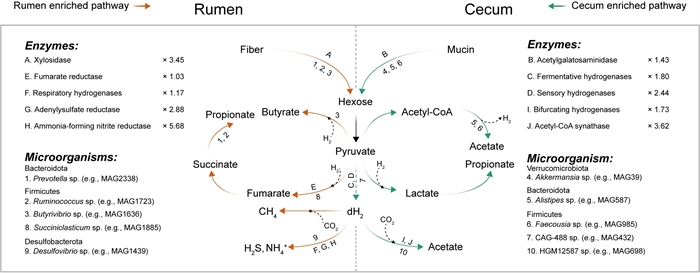Researchers Reveal Microbial Mechanism Behind Low Methane Emissions in Ruminant Hindgut
A research team led by Prof. Tan Zhiliang from the Institute of Subtropical Agriculture, Chinese Academy of Sciences, has uncovered the microbial mechanisms underlying the low methane emission trait in the hindgut of ruminants. Their groundbreaking study, titled “Reductive acetogenesis is a dominant process in the ruminant hindgut” was recently published in the prestigious microbiology journal Microbiome on January 28.
Ruminants, a cornerstone of animal husbandry and among the earliest domesticated livestock, possess a unique digestive system reliant on microbial fermentation to break down plant-based feed into volatile fatty acids (VFAs)—their primary energy source. However, this process also makes ruminants the largest methane emitters in agricultural activities. The ruminant digestive tract comprises multiple stomach chambers (e.g., the rumen) and the hindgut (e.g., the cecum). While both regions are dominated by anaerobic fermentation, over 90% of methane is produced in the rumen. Despite the cecum’s characteristic low methane emissions, its microbial composition and metabolic functions have remained poorly understood.
The study systematically compared microbial composition, metabolic functions, and activity between the rumen and cecum (Figure 1). Results showed that the rumen is enriched with fiber-degrading microbes such as Prevotella, Ruminococcus, and Butyrivibrio, enhancing cellulose breakdown and propionate production while promoting methanogen proliferation and methane generation. Low dissolved hydrogen concentrations in the rumen were attributed to hydrogen consumption by hydrogenotrophic methanogens, fumarate-reducing bacteria (Succinivibrionaceae), and nitrate-reducing bacteria (Desulfovibrio). In contrast, the cecum harbored mucin-degrading bacteria such as Akkermansia, Alistipes, and Faecalibacterium, which boosted host-derived carbohydrate utilization and acetate synthesis. Notably, the cecum exhibited a unique enrichment of hydrogen-producing fermentative bacteria and a novel lineage of formate-dependent acetogens (HGM1287). Comparative genomic analysis revealed distinct phylogenetic and functional differences between cecal and ruminal acetogens. Cross-species comparisons further confirmed that acetogenesis is a critical metabolic process in the hindgut of ruminants, serving as a key microbial driver for low methane emissions and efficient hydrogen utilization in the cecum.
“This study elucidates how reductive acetogenesis dominates hindgut microbial metabolism, offering a scientific foundation for developing strategies to mitigate methane emissions in ruminant livestock.” said Prof. Wang Min, the corresponding authors of the study, “which highlights the potential of modulating hindgut microbiota to enhance both ecological sustainability and production efficiency in animal agriculture.”
Contact: Min Wang
E-mail: mwang@isa.ac.cn

Comparative analysis of microbial composition and metabolic pathways in the rumen and cecum (Imaged by Qiushuang Li)
Download attachments: